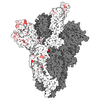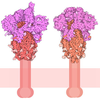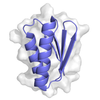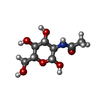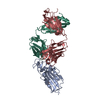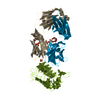[English] 日本語
 Yorodumi
Yorodumi- PDB-7ks9: Cryo-EM structure of prefusion SARS-CoV-2 spike glycoprotein in c... -
+ Open data
Open data
- Basic information
Basic information
| Entry | Database: PDB / ID: 7ks9 | ||||||
|---|---|---|---|---|---|---|---|
| Title | Cryo-EM structure of prefusion SARS-CoV-2 spike glycoprotein in complex with 910-30 Fab | ||||||
 Components Components |
| ||||||
 Keywords Keywords | Viral Protein/IMMUNE SYSTEM / Neutralizing antibody / Fusion protein / Spike glycoprotein / COVID-19 / RBD / Viral protein / IMMUNE SYSTEM / Viral Protein-IMMUNE SYSTEM complex | ||||||
| Function / homology |  Function and homology information Function and homology informationsymbiont-mediated disruption of host tissue / Maturation of spike protein / Translation of Structural Proteins / Virion Assembly and Release / host cell surface / host extracellular space / viral translation / symbiont-mediated-mediated suppression of host tetherin activity / Induction of Cell-Cell Fusion / structural constituent of virion ...symbiont-mediated disruption of host tissue / Maturation of spike protein / Translation of Structural Proteins / Virion Assembly and Release / host cell surface / host extracellular space / viral translation / symbiont-mediated-mediated suppression of host tetherin activity / Induction of Cell-Cell Fusion / structural constituent of virion / entry receptor-mediated virion attachment to host cell / membrane fusion / Attachment and Entry / host cell endoplasmic reticulum-Golgi intermediate compartment membrane / positive regulation of viral entry into host cell / receptor-mediated virion attachment to host cell / host cell surface receptor binding / symbiont-mediated suppression of host innate immune response / receptor ligand activity / endocytosis involved in viral entry into host cell / fusion of virus membrane with host plasma membrane / fusion of virus membrane with host endosome membrane / viral envelope / symbiont entry into host cell / virion attachment to host cell / SARS-CoV-2 activates/modulates innate and adaptive immune responses / host cell plasma membrane / virion membrane / identical protein binding / membrane / plasma membrane Similarity search - Function | ||||||
| Biological species |  Homo sapiens (human) Homo sapiens (human) | ||||||
| Method | ELECTRON MICROSCOPY / single particle reconstruction / cryo EM / Resolution: 4.75 Å | ||||||
 Authors Authors | Cerutti, G. / Shapiro, L. | ||||||
| Funding support |  China, 1items China, 1items
| ||||||
 Citation Citation |  Journal: Cell Rep / Year: 2021 Journal: Cell Rep / Year: 2021Title: Paired heavy- and light-chain signatures contribute to potent SARS-CoV-2 neutralization in public antibody responses. Authors: Bailey B Banach / Gabriele Cerutti / Ahmed S Fahad / Chen-Hsiang Shen / Matheus Oliveira De Souza / Phinikoula S Katsamba / Yaroslav Tsybovsky / Pengfei Wang / Manoj S Nair / Yaoxing Huang / ...Authors: Bailey B Banach / Gabriele Cerutti / Ahmed S Fahad / Chen-Hsiang Shen / Matheus Oliveira De Souza / Phinikoula S Katsamba / Yaroslav Tsybovsky / Pengfei Wang / Manoj S Nair / Yaoxing Huang / Irene M Francino-Urdániz / Paul J Steiner / Matías Gutiérrez-González / Lihong Liu / Sheila N López Acevedo / Alexandra F Nazzari / Jacy R Wolfe / Yang Luo / Adam S Olia / I-Ting Teng / Jian Yu / Tongqing Zhou / Eswar R Reddem / Jude Bimela / Xiaoli Pan / Bharat Madan / Amy D Laflin / Rajani Nimrania / Kwok-Yung Yuen / Timothy A Whitehead / David D Ho / Peter D Kwong / Lawrence Shapiro / Brandon J DeKosky /   Abstract: Understanding mechanisms of protective antibody recognition can inform vaccine and therapeutic strategies against SARS-CoV-2. We report a monoclonal antibody, 910-30, targeting the SARS-CoV-2 ...Understanding mechanisms of protective antibody recognition can inform vaccine and therapeutic strategies against SARS-CoV-2. We report a monoclonal antibody, 910-30, targeting the SARS-CoV-2 receptor-binding site for ACE2 as a member of a public antibody response encoded by IGHV3-53/IGHV3-66 genes. Sequence and structural analyses of 910-30 and related antibodies explore how class recognition features correlate with SARS-CoV-2 neutralization. Cryo-EM structures of 910-30 bound to the SARS-CoV-2 spike trimer reveal binding interactions and its ability to disassemble spike. Despite heavy-chain sequence similarity, biophysical analyses of IGHV3-53/3-66-encoded antibodies highlight the importance of native heavy:light pairings for ACE2-binding competition and SARS-CoV-2 neutralization. We develop paired heavy:light class sequence signatures and determine antibody precursor prevalence to be ∼1 in 44,000 human B cells, consistent with public antibody identification in several convalescent COVID-19 patients. These class signatures reveal genetic, structural, and functional immune features that are helpful in accelerating antibody-based medical interventions for SARS-CoV-2. #1: Journal: bioRxiv / Year: 2021 Title: Paired heavy and light chain signatures contribute to potent SARS-CoV-2 neutralization in public antibody responses. Abstract: Understanding protective mechanisms of antibody recognition can inform vaccine and therapeutic strategies against SARS-CoV-2. We discovered a new antibody, 910-30, that targets the SARS-CoV-2 ACE2 ...Understanding protective mechanisms of antibody recognition can inform vaccine and therapeutic strategies against SARS-CoV-2. We discovered a new antibody, 910-30, that targets the SARS-CoV-2 ACE2 receptor binding site as a member of a public antibody response encoded by IGHV3-53/IGHV3-66 genes. We performed sequence and structural analyses to explore how antibody features correlate with SARS-CoV-2 neutralization. Cryo-EM structures of 910-30 bound to the SARS-CoV-2 spike trimer revealed its binding interactions and ability to disassemble spike. Despite heavy chain sequence similarity, biophysical analyses of IGHV3-53/3-66 antibodies highlighted the importance of native heavy:light pairings for ACE2 binding competition and for SARS-CoV-2 neutralization. We defined paired heavy:light sequence signatures and determined antibody precursor prevalence to be ~1 in 44,000 human B cells, consistent with public antibody identification in several convalescent COVID-19 patients. These data reveal key structural and functional neutralization features in the IGHV3-53/3-66 public antibody class to accelerate antibody-based medical interventions against SARS-CoV-2. HIGHLIGHTS: A molecular study of IGHV3-53/3-66 public antibody responses reveals critical heavy and light chain features for potent neutralizationCryo-EM analyses detail the structure of a novel ...HIGHLIGHTS: A molecular study of IGHV3-53/3-66 public antibody responses reveals critical heavy and light chain features for potent neutralizationCryo-EM analyses detail the structure of a novel public antibody class member, antibody 910-30, in complex with SARS-CoV-2 spike trimerCryo-EM data reveal that 910-30 can both bind assembled trimer and can disassemble the SARS-CoV-2 spikeSequence-structure-function signatures defined for IGHV3-53/3-66 class antibodies including both heavy and light chainsIGHV3-53/3-66 class precursors have a prevalence of 1:44,000 B cells in healthy human antibody repertoires. | ||||||
| History |
|
- Structure visualization
Structure visualization
| Movie |
 Movie viewer Movie viewer |
|---|---|
| Structure viewer | Molecule:  Molmil Molmil Jmol/JSmol Jmol/JSmol |
- Downloads & links
Downloads & links
- Download
Download
| PDBx/mmCIF format |  7ks9.cif.gz 7ks9.cif.gz | 588 KB | Display |  PDBx/mmCIF format PDBx/mmCIF format |
|---|---|---|---|---|
| PDB format |  pdb7ks9.ent.gz pdb7ks9.ent.gz | 471.8 KB | Display |  PDB format PDB format |
| PDBx/mmJSON format |  7ks9.json.gz 7ks9.json.gz | Tree view |  PDBx/mmJSON format PDBx/mmJSON format | |
| Others |  Other downloads Other downloads |
-Validation report
| Summary document |  7ks9_validation.pdf.gz 7ks9_validation.pdf.gz | 3.5 MB | Display |  wwPDB validaton report wwPDB validaton report |
|---|---|---|---|---|
| Full document |  7ks9_full_validation.pdf.gz 7ks9_full_validation.pdf.gz | 3.5 MB | Display | |
| Data in XML |  7ks9_validation.xml.gz 7ks9_validation.xml.gz | 90.7 KB | Display | |
| Data in CIF |  7ks9_validation.cif.gz 7ks9_validation.cif.gz | 136.7 KB | Display | |
| Arichive directory |  https://data.pdbj.org/pub/pdb/validation_reports/ks/7ks9 https://data.pdbj.org/pub/pdb/validation_reports/ks/7ks9 ftp://data.pdbj.org/pub/pdb/validation_reports/ks/7ks9 ftp://data.pdbj.org/pub/pdb/validation_reports/ks/7ks9 | HTTPS FTP |
-Related structure data
| Related structure data |  23016MC M: map data used to model this data C: citing same article ( |
|---|---|
| Similar structure data |
- Links
Links
- Assembly
Assembly
| Deposited unit | 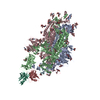
|
|---|---|
| 1 |
|
- Components
Components
| #1: Antibody | Mass: 23518.000 Da / Num. of mol.: 1 Source method: isolated from a genetically manipulated source Source: (gene. exp.)  Homo sapiens (human) / Production host: Homo sapiens (human) / Production host:  Homo sapiens (human) Homo sapiens (human) | ||||||||
|---|---|---|---|---|---|---|---|---|---|
| #2: Antibody | Mass: 23412.219 Da / Num. of mol.: 1 Source method: isolated from a genetically manipulated source Source: (gene. exp.)  Homo sapiens (human) / Production host: Homo sapiens (human) / Production host:  Homo sapiens (human) Homo sapiens (human) | ||||||||
| #3: Protein | Mass: 142399.375 Da / Num. of mol.: 3 Source method: isolated from a genetically manipulated source Source: (gene. exp.)  Gene: S, 2 / Production host:  Homo sapiens (human) / References: UniProt: P0DTC2 Homo sapiens (human) / References: UniProt: P0DTC2#4: Polysaccharide | 2-acetamido-2-deoxy-beta-D-glucopyranose-(1-4)-2-acetamido-2-deoxy-beta-D-glucopyranose Source method: isolated from a genetically manipulated source #5: Sugar | ChemComp-NAG / Has ligand of interest | Y | Has protein modification | Y | |
-Experimental details
-Experiment
| Experiment | Method: ELECTRON MICROSCOPY |
|---|---|
| EM experiment | Aggregation state: PARTICLE / 3D reconstruction method: single particle reconstruction |
- Sample preparation
Sample preparation
| Component | Name: Prefusion SARS-CoV-2 spike glycoprotein in complex with 910-30 Fab Type: COMPLEX / Entity ID: #1-#3 / Source: RECOMBINANT |
|---|---|
| Source (natural) | Organism:  Homo sapiens (human) Homo sapiens (human) |
| Source (recombinant) | Organism:  Homo sapiens (human) Homo sapiens (human) |
| Buffer solution | pH: 5.5 |
| Specimen | Embedding applied: NO / Shadowing applied: NO / Staining applied: NO / Vitrification applied: YES |
| Vitrification | Cryogen name: ETHANE |
- Electron microscopy imaging
Electron microscopy imaging
| Experimental equipment |  Model: Titan Krios / Image courtesy: FEI Company |
|---|---|
| Microscopy | Model: FEI TITAN KRIOS |
| Electron gun | Electron source:  FIELD EMISSION GUN / Accelerating voltage: 300 kV / Illumination mode: OTHER FIELD EMISSION GUN / Accelerating voltage: 300 kV / Illumination mode: OTHER |
| Electron lens | Mode: BRIGHT FIELD |
| Image recording | Electron dose: 42 e/Å2 / Film or detector model: GATAN K3 BIOQUANTUM (6k x 4k) |
- Processing
Processing
| EM software |
| ||||||||||||||||||||||||||||||
|---|---|---|---|---|---|---|---|---|---|---|---|---|---|---|---|---|---|---|---|---|---|---|---|---|---|---|---|---|---|---|---|
| CTF correction | Type: PHASE FLIPPING AND AMPLITUDE CORRECTION | ||||||||||||||||||||||||||||||
| Symmetry | Point symmetry: C1 (asymmetric) | ||||||||||||||||||||||||||||||
| 3D reconstruction | Resolution: 4.75 Å / Resolution method: FSC 0.143 CUT-OFF / Num. of particles: 88315 / Symmetry type: POINT | ||||||||||||||||||||||||||||||
| Atomic model building | Protocol: FLEXIBLE FIT | ||||||||||||||||||||||||||||||
| Atomic model building | 3D fitting-ID: 1 / Source name: PDB / Type: experimental model
|
 Movie
Movie Controller
Controller




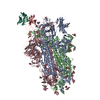
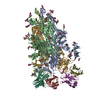
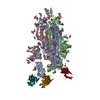
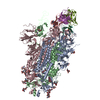



 PDBj
PDBj
